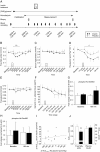Intranasal insulin suppresses systemic but not subcutaneous lipolysis in healthy humans
- PMID: 24423295
- PMCID: PMC3913807
- DOI: 10.1210/jc.2013-3169
Intranasal insulin suppresses systemic but not subcutaneous lipolysis in healthy humans
Abstract
Context: Insulin infused into the central nervous system of rats suppresses lipolysis in white adipose tissue, indicating a role of brain insulin in regulating systemic lipid metabolism.
Objective: We investigated whether central nervous insulin delivery suppresses lipolysis in healthy humans.
Design: Placebo-controlled, balanced within-subject comparisons were performed in both a main and an independent corroborative experiment. SETTING/PARTICIPANTS/INTERVENTION: Two groups of healthy volunteers were examined at the German University Clinics of Lübeck and Tübingen, respectively, with molecular analyses taking place at Mt Sinai School of Medicine (New York, New York). The 14 healthy male subjects of the main study and the 22 women and 5 men of the corroborative study each received 160 IU of human insulin intranasally.
Main outcome measures: In the main study, we measured systemic levels of free fatty acids (FFAs), triglycerides, and glycerol and the rate of appearance of deuterated glycerol as an estimate of lipolysis before and after intranasal insulin administration. We also analyzed the expression of key lipolytic enzymes in sc fat biopsies and measured blood glucose and glucoregulatory hormones. In the corroborative study, FFA concentrations were assessed before and after intranasal insulin administration.
Results: In the main experiment, intranasal insulin suppressed circulating FFA concentrations and lipolysis (rate of appearance of deuterated glycerol) in the absence of significant changes in circulating insulin levels. Lipolytic protein expression in sc adipose tissue was not affected. The corroborative study confirmed that intranasal insulin lowers systemic FFA concentrations.
Conclusions: Our findings indicate that brain insulin controls systemic lipolysis in healthy humans by predominantly acting on non-sc adipose tissue.
Figures

References
-
- Lafontan M, Langin D. Lipolysis and lipid mobilization in human adipose tissue. Prog Lipid Res. 2009;48:275–297 - PubMed
-
- Bluher M, Michael MD, Peroni OD, et al. Adipose tissue selective insulin receptor knockout protects against obesity and obesity-related glucose intolerance. Dev Cell. 2002;3:25–38 - PubMed
Publication types
MeSH terms
Substances
Grants and funding
LinkOut - more resources
Full Text Sources
Other Literature Sources
Medical

